
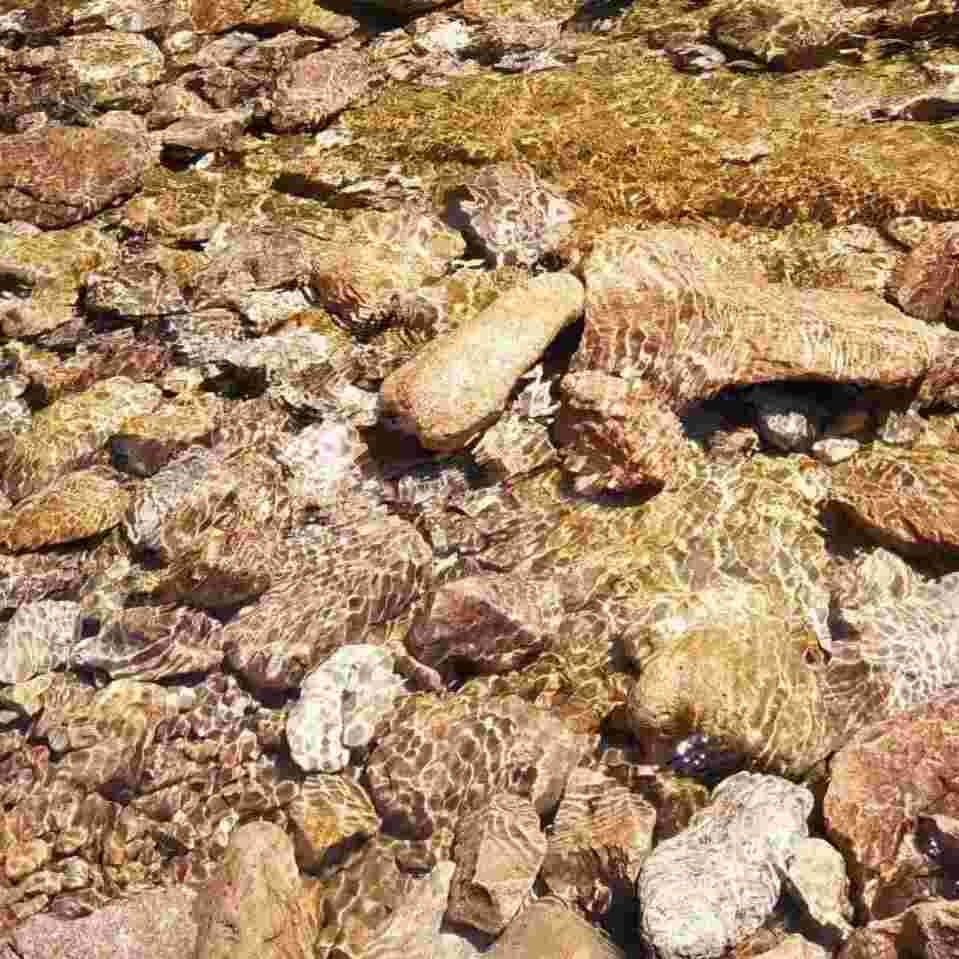
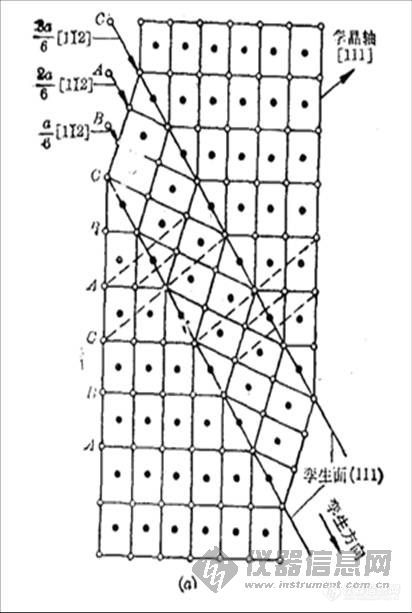
Jin
第2楼2008/06/20
我也觉得图像已经变形。总体上同意你的观点。不过就对于FCC的化合物,比如堆垛为AaBbCcAaBbCc,那么在{111}孪晶后,需区别是镜面孪晶还是旋转孪晶吧。此时二者不在等价。
蓝莓口香糖
第3楼2008/06/20
ABC在FCC中是等价的。在孪晶中,假设左侧朝向孪晶面是ABCABC的堆垛顺序,在C处出现了孪晶面。因为孪晶面是两侧晶体的公共面,所以C也是右侧晶体的第一个面。右侧晶体也是FCC,111面的堆垛方式不变,所以从孪晶面开始只能是CBACBA或者CABCAB,如果是后者,那就和左侧完全一样,不能形成孪晶。所以必然是CBACBA的堆垛顺序,和左侧呈镜面对称。
对于旋转孪晶,由下面那篇文章的解释应该是绕111轴转了60度。假设左侧是ABCABCA,然后B绕111转60度。根据111面组的格点投影,绕111转60度后,C变成B,A不变,B变成C。所以右侧原来的BCABCA就变成CBACBA。整个孪晶从左到右为ABCABCA·CBACBA,仍然镜面对称。这就是镜面孪晶。不过我好象没算错,问题是FCC的111面太特殊。这样看来,旋转孪晶对ABC的等价性没影响?!有实践经验的指教一下。哈
找到一个中文的PPT,前面的矩阵计算很枯燥,后面的例子很不错。转自
http://biom.3322.org:2966/common/01%20Public/05-%E8%AF%BE%E7%A8%8B%E5%AD%A6%E4%B9%A0-%E8%B5%84%E6%A0%BC%E8%80%83%E8%AF%95/%E6%98%BE%E5%BE%AE%E5%88%86%E6%9E%90/Diff_Contrast3.ppt twinninig in crystal
twinninig in crystal
蓝莓口香糖
第4楼2008/06/20
转贴一个讲孪晶的网页,来自Tulane University Prof. Stephen A. Nelson
http://www.tulane.edu/~sanelson/eens211/twinning.htm
Twinning in Crystals
Sometimes during the growth of a crystal, or if the crystal is subjected to stress or temperature/pressure conditions different from those under which it originally formed, two or more intergrown crystals are formed in a symmetrical fashion. These symmetrical intergrowths of crystals are called twinned crystals. Twinning is important to recognize, because when it occurs, it is often one of the most diagnostic features enabling identification of the mineral.
What happens is that lattice points in one crystal are shared as lattice points in another crystal adding apparent symmetry to the crystal pairs. Twinning, because it adds symmetry, never occurs in relation to the existing symmetry of the crystal. 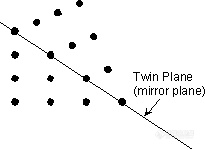
Symmetry Operations that Define Twinning
Because symmetry is added to a crystal by twinning, twining can be defined by the symmetry operations that are involved. These include:
。Reflection across a mirror plane. The added mirror plane would then be called a twin plane.
。Rotation about an axis or line in the crystal. The added rotation axis would then be called a twin axis.
。Inversion through a point. The added center of symmetry would then be called a twin center.
Twin Laws
Twin laws are expressed as either form symbols to define twin planes (i.e. {hkl}) or zone symbols to define the direction of twin axes (i.e. [hkl]).
The surface along which the lattice points are shared in twinned crystals is called a composition surface.
If the twin law can be defined by a simple planar composition surface, the twin plane is always parallel to a possible crystal face and never parallel to an existing plane of symmetry (remember that twinning adds symmetry).
If the twin law is a rotation axis, the composition surface will be irregular, the twin axis will be perpendicular to a lattice plane, but will never be an even-fold rotation axis of the existing symmetry. For example twinning cannot occur on a new 2 fold axis that is parallel to an existing 4-fold axis.
Types of Twinning
Another way of defining twinning breaks twins into two separate types.
1. Contact Twins - have a planar composition surface separating 2 individual crystals. These are usually defined by a twin law that expresses a twin plane (i.e. an added mirror plane). An example shown here is a crystal of orthoclase twinned on the Braveno Law, with {021} as the twin plane.
2. Penetration Twins - have an irregular composition surface separating 2 individual crystals. These are defined by a twin center or twin axis. Shown here is a twinned crystal of orthoclase twinned on the Carlsbad Law with [001] as the twin axis.
Contact twins can also occur as repeated or multiple twins.
。If the compositions surfaces are parallel to one another, they are called polysynthetic twins. Plagioclase commonly shows this type of twinning, called the Albite Twin Law, with {010} as the twin plane. Such twinning is one of the most diagnostic features of plagioclase.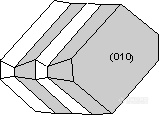
。If the composition surfaces are not parallel to one another, they are called cyclical twins. Shown here is the cyclical twin that occurs in chrysoberyl along a {031} plane. 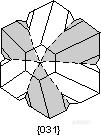
蓝莓口香糖
第5楼2008/06/20
Origin of Twinning
Twinning can originate in 3 different ways, as growth twins, transformation twins, and glide or deformation twins.
1. Growth Twins - When accidents occur during crystal growth and a new crystal is added to the face of an already existing crystal, twinning can occur if the new crystal shares lattice points on the face of the existing crystal, but has an orientation different from the original crystal. Such growth twins can be contact twins, as illustrated here, or can be penetration twins. All of twins discussed so far are growth twins. 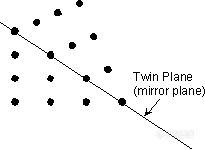
2. Transformation Twins - Transformation twinning occurs when a preexisting crystal undergoes a transformation due to a change in pressure or temperature. This commonly occurs in minerals that have different crystal structures and different symmetry at different temperatures or pressures. When the temperature or pressure is changed to that where a new crystal structure and symmetry is stable, different parts of the crystal become arranged in different symmetrical orientations, and thus form an intergrowth of one or more crystals. Dauphiné and Brazil twinning in quartz commonly forms this way during a decrease in temperature.
Similarly the combination of albite twinning and pericline twinning in alkali feldspar results when high temperature sanidine (monoclinic) transforms to low temperature microcline (triclinic). This type of twinning is only observed using the polarizing microscope, and results in a "tartan" twinning pattern as shown in your text book on page 231, figure10.18. When this twinning pattern is observed with the microscope it is one of the most characteristic diagnostic properties for the identification of microcline.
3. Deformation Twins - During deformation atoms can be pushed out of place. If this happens to produce a symmetrical arrangement, it produces deformation twins. The mineral calcite can be easily twinned in this way, producing polysynthetic twins on {01-12}. 
蓝莓口香糖
第6楼2008/06/20
Common Twin Laws
1. Triclinic System - The feldspar minerals plagioclase and microcline are the most common triclinic minerals that show twinning. Two common twin laws are observed in these feldspars.
。Albite Law - As described above, plagioclase (NaAlSi3O8 - CaAl2Si2O8) very commonly shows albite polysynthetic twinning. The twin law - {010} indicates that the twining occurs perpendicular to the b crystallographic axis. Albite twinning is so common in plagioclase, that it's presence is a diagnostic property for identification of plagioclase. 
。Pericline Law - The pericline law has [010] as the twin axis. As stated above, pericline twinning occurs as the result of monoclinic orthoclase or sanidine transforming to microcline (all have the same chemical formula - KAlSi3O8). Pericline twinning usually occurs in combination with albite twinning in microcline, but is only observable with the polarizing microscope. The combination of pericline and albite twinning produce a cross-hatched pattern, called tartan twinning, as discussed above, that easily distinguishes microcline from the other feldspars under the microscope.
2. Monoclinic System - The most common twins in the monoclinic system occur on the planes {100} and {001}. The feldspars - orthoclase and sanidine - are the most commonly twinned minerals in the monoclinic system. Both contact twins and penetration twins occur, and both types result from accidents during growth.
。Manebach Law - {001} - forms a contact twin commonly observed in the mineral orthoclase. This twinning is very diagnostic of orthoclase when it occurs. 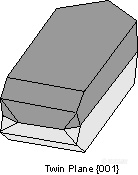
。Carlsbad Law - [001] - forms a penetration twin in the mineral orthoclase. Crystals twinned under the Carlsbad Law show two intergrown crystals, one rotated 180o from the other about the [001] axis. Carlsbad twinning is the most common type of twinning in orthoclase, and is thus very diagnostic of orthoclase when it occurs. 
。Braveno Law - {021} - forms a contact twin in the mineral orthoclase. 
。Swallow Tail Twins - {100}- are commonly observed in the mineral gypsum (CaSO4.2H2O). 
3. Orthorhombic System - Orthorhombic crystals commonly twin on planes parallel to a prism face. The most common is a {110} twin that results in many orthorhombic minerals having cyclical twins.
。{110} Cyclical Twins - The mineral aragonite (CaCO3) , chrysoberyl (BeAl2O4), and cerrusite (PbCO3) commonly develop twinning on {110}. This results in a cyclical twin which gives these minerals a pseudo-hexagonal appearance. 
。Staurolite Law - The mineral staurolite is really monoclinic, but it has a ß angle very close to 90o so it has the appearance of an orthorhombic mineral. Two types of interpenetration twins occur in staurolite the {031} twins from a right-angled cross and the {231} twins form a cross at about 60o. 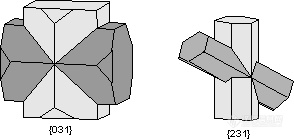
4. Tetragonal System - Twinning in the tetragonal system usually occurs on {011} forming cyclical contact twins. The minerals rutile (TiO2) and cassiterite (SnO2) commonly show this type of twinning. 
5. Hexagonal System - The minerals calcite (CaCO3) and quartz (SiO2) are the most common hexagonal minerals and both show the types of twinning common in hexagonal minerals.
。Calcite Twins - The two most common twin laws that are observed in calcite crystals are {0001} and the rhombohedron {01-12}. Both are contact twins, but the {01-12} twins can also occur as polysynthetic twins that result from deformation. 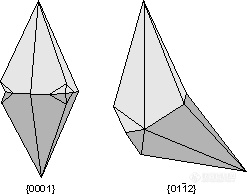
Quartz shows three other hexagonal twins.
。Brazil Law - {11-20} - is a penetration twin that results from transformation.
。Dauphiné Law - [0001] - is also a penetration twin that results from transformation.
。Japanese Law - {11-22} - is a contact twin that results from accidents during growth.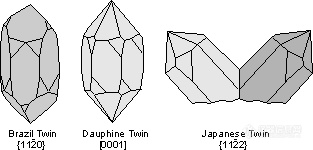
6. Isometric System - Three types of twins are common in the isometric system.
。Spinel Law - {-1-11} - is a twin plane, parallel to an octahedron. It occurs commonly in mineral spinel (MgAl2O4). 
。[111] - The twin axis perpendicular to an octahedral face adds three fold rotational symmetry. 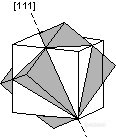
。Iron Cross [001] - The mineral pyrite (FeS2) often shows the iron cross made of the interpenetration of two pyritohedrons. Since this occurs in the class 2/m-3, with no 4-fold rotation axes, the [001] twin axis gives the mineral apparent 4-fold symmetry about 3 perpendicular axes. 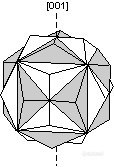
转贴完